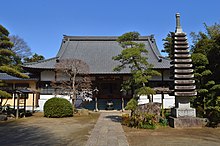| Kazusa Kokubun-ji | |
|---|---|
| 上総国分寺 | |
 Kazusa Kokubun-ji Hondō Kazusa Kokubun-ji Hondō | |
| Religion | |
| Affiliation | Buddhist |
| Deity | Yakushi Nyorai |
| Rite | Shingon-shu Buzan-ha |
| Status | active |
| Location | |
| Location | 1-7-23 Soja, Ichihara-shi, Chiba-ken |
| Country | Japan |
  | |
| Geographic coordinates | 35°29′47″N 140°06′41″E / 35.49639°N 140.11139°E / 35.49639; 140.11139 |
| Architecture | |
| Founder | Emperor Shōmu |
| Completed | 741AD |
| National Historic Site of Japan | |
Kazusa Kokubun-ji (上総国分寺) is a Buddhist temple in Ichihara, Chiba, Japan, belonging to the Shingon-shu Buzan-ha sect, and is the provincial temple ("kokubunji") of former Kazusa Province. The present temple is of uncertain foundation, but claims to be the direct descendant of the original Nara period kokubunji temple which fell into ruins sometime in the Muromachi period. The Nara-period temple ruins were designated a National Historic Site in 1929, with the area under protection expanded in 1979 due to additional archaeological finds.
Overview
The Shoku Nihongi records that in 741 AD, as the country recovered from a major smallpox epidemic, Emperor Shōmu ordered that a monastery and nunnery be established in every province, the kokubunji (国分寺).
The Kazusa Kokubun-ji was located on the northern bank of the Yōrō River, in an area with a high concentration of kofun and ancient sites. The ancient temple is mentioned in historical records to the Oei era (1394-1427), but appears to have fallen into ruin after then. It was revived during the Edo period during the Genroku era (1688-1704) and the current main hall, a Yakushi-dō, was built in 1716 on the site of the old temple. The temple's Niōmon also dates from the Edo period, but one of the statues within is a survivor from the Nanboku-chō period.
-
 Niomon, City ICP
Niomon, City ICP
-
 Yakushi-do, City ICP
Yakushi-do, City ICP
-
 Memorial stupa to Taira no Masakado, City ICP
Memorial stupa to Taira no Masakado, City ICP
Ancient Kazusa Kokubun-ji
The remains of original kokubunji overlap with the current temple precincts. The temple area for the ancient Kazusa Kokubun-ji is not square because there are valleys and burial mounds around it. Roughly, it measured 478 meters north-to-south by between 254 meters and 345 meters from east-to-west, for a total area of 139,000 square meters. The inner compound containing the main buildings of the temple was 219 meters north-to-south by 194 meters east-to-west, and unlike other kokubunji temples, did not adhere to the standardized layout, but was patterned instead after Daian-ji in Asuka.
The site was located in 1929 with the discovery of large number of roof tiles inscribed "kokubun-ji" in the location. An archaeological excavation in 1966 confirmed the foundation stones for the Kondō, and Lecture Hall, and the middle gate as well as that of a pagoda. From the size of the foundations for the pagoda, it is estimated that the completed structure was a seven-story building with a height of around 60-meters. The remains of a group of kilns for producing roof tiles were located in a survey conducted in 1974 to the west of the main temple complex. The temple site is located a 15-minute walk from Kazusa-Murakami Station on the Kominato Railway Kominato Line.
-
 Site of Kondō
Site of Kondō
-
 Site of the Pagoda
Site of the Pagoda
-
 Foundation stone of pagoda
Foundation stone of pagoda
-
 Site of West Gate
Site of West Gate
-
Inscribed pottery shards
-
 Site of tile kilns
Site of tile kilns
See also
References
- 上総国分寺跡. Cultural Heritage Online (in Japanese). Agency for Cultural Affairs. Retrieved 25 May 2020.
- Brown, Delmer M. (1993). Cambridge History of Japan vol. I. Cambridge University Press. p. 255.
- Yiengpruksawan, Mimi Hall (1998). Hiraizumi: Buddhist Art and Regional Politics in Twelfth-Century Japan. Harvard University Press. pp. 22f.
- ^ Isomura, Yukio; Sakai, Hideya (2012). (国指定史跡事典) National Historic Site Encyclopedia. 学生社. ISBN 4311750404.(in Japanese)
External links
- Chiba Prefectural Board of Education (in Japanese)
- Ichihara City home page (in Japanese)